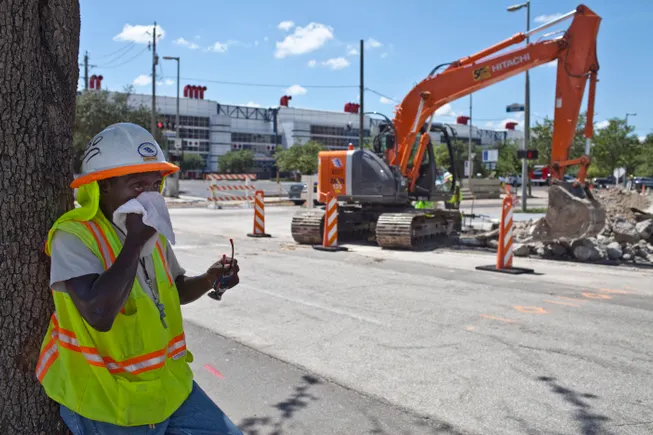Editor’s note: This is the first article in a two-part HR Dive series about the effects of climate change on worker health. Part two will focus on workplace safety strategies and the growing push by state and federal lawmakers to establish heat-safety standards.
Sixteen million dollars, every hour. That’s the global cost of climate change between 2010 and 2019 as estimated by New Zealand-based researchers, a figure that amounts to $143 billion per year on average. By 2050, the annual cost could balloon to as much as $3.1 trillion.
Those numbers incorporate a boatload of data points. But when Tracy Watts, senior partner and national leader for U.S. health policy at HR consulting firm Mercer, and her colleagues looked for precise data that captured just how much climate change would cost the typical employer-sponsored health plan, they largely came up empty.
There’s historical data showing an increase in natural disasters thought to be exacerbated by climate change, Watts said. “Most of the focus around that is more on sustainability, which is great, but we were wondering what impact this is having on human capital. And there wasn’t really anything out there.”
So Mercer and the National Commission on Climate and Workforce, an initiative of the Health Action Alliance, set about developing an online tool, the Climate Health Cost Forecaster, to determine the long-term health costs associated with key climate-related “perils,” as Watts called them, that could account for a given employer’s industry, location and workforce size.
Released last month, the forecaster combines weather data and epidemiological research with Mercer’s own health claims database to project costs over a ten-year span. It hones in on four specific perils — extreme heat, poor air quality, flooding and hurricanes — because the developers felt they could make the strongest correlations between those particular scenarios and an individual’s health, Watts said.
The tool speaks to a real informational need, she continued, citing Mercer’s late 2024 global survey which found that 77% of employees said they or a family member had been negatively affected by climate events or extreme weather. Specific issues ranged from cost-of-living increases to decreased ability to access care to difficulty sleeping due to high temperatures.
Men on a four wheeler pass a storm-damaged house along Mill Creek in the aftermath of Hurricane Helene on Sept. 30, 2024, in Old Fort, N.C. Extreme weather events like floods can be linked to a number of medical conditions, according to researchers.
Sean Rayford via Getty Images
A multifaceted ‘threat multiplier’
Using scientific journals, Mercer and its co-developers identified specific medical conditions that could be linked to each of the forecaster’s four perils. The process is straightforward in many examples: extreme heat can increase incidences of dehydration, heat stroke and cardiovascular and respiratory illnesses, while poor air quality has a similar connection to respiratory ailments and allergic reactions.
But there are even more conditions for which the tool accounts, Watts said. Extreme heat alone can cause people who are pregnant to prematurely go into labor, and it also can have a more detrimental effect on workers’ dependents, especially children. Flooding can lead to physical injuries as well as vector-borne and waterborne diseases.
Climate change spurs cost-of-living and health concerns globally
% of global respondents who said they or a family member saw any of the following affected due to climate change or extreme weather events
Climate change affects physical health as well as overall well-being, Ellen Kelsay, president and CEO of the Business Group on Health, said in an email. It is also a “threat multiplier,” she added, because it can exacerbate existing health issues, especially for at-risk populations, and may result in greater psychological trauma and stress.
“Extreme climate-related events such as hurricanes, wildfires and floods, can displace people from their homes, causing great distress and difficulty in seeking health care services,” Kelsay said. “These events also are linked to acute disruptions such as power outages and supply challenges.”
There are also long-term health concerns associated with heat and environmental stressors, such as chronic kidney disease and worsening of conditions like asthma and diabetes, Jessica Martinez, executive director of the National Council for Occupational Safety and Health, a worker-led advocacy group, said in an email.
Martinez noted that large disparities can exist between workers in different settings, and those in low-wage and high-risk occupations in the construction, agriculture, hospitality and manufacturing industries are often subject to extreme conditions. The same workers may lack access to basic safeguards such as water, rest and shade, she said.
“Workers in these jobs are disproportionately people of color and immigrants, and many don’t have access to healthcare at all, let alone preventive care,” Martinez said. “Even when they do seek medical help, providers rarely ask if symptoms like dizziness, fainting, or chronic pain are related to their jobs. So the conditions go underreported, misdiagnosed, and untreated. This systemic failure keeps the suffering invisible and allows dangerous conditions to continue unchecked.”

A farm worker labors in a field on Aug. 11, 2004, near Bakersfield, Calif. Workers in industries such as agriculture are particularly vulnerable to climate-related health risks because they generally lack access to climate-controlled environments.
David McNew via Getty Images
Employers overlook climate change’s health impact
Healthcare costs have historically been a sticking point for organizational budgets and that is unlikely to change in the near future, with a recent WTW survey analysis calling recent cost increases “unsustainable.” Yet, even as employers struggle with their plan spending, Watts said some may overlook climate change’s contributions.
“Any [chief financial officer] of an organization knows what their health benefits spend is — it’s a big number. They know how much it goes up every year,” Watts said. Even if climate-related effects contribute a single percentage point toward spending increases, she continued, “that’s a meaningful amount to an organization and to a CFO.”
Martinez said she is similarly concerned that company leaders may not account for the human costs of climate change in their fiscal planning, even as extreme weather events create more dangerous and potentially deadly working conditions for some workers. Heat is a primary focus given that nine of the 10 warmest years on record in the contiguous U.S. have occurred since 1998, but Martinez said basic safety best practices are not always implemented to protect vulnerable workers.
“Too often, we see a lack of investment in programs and solutions that could reduce the risk of heat illness, such as access to water, rest, shade, and changes to work schedules,” she said. “Failing to act not only puts workers’ lives at risk but also leads to turnover, burnout, and long-term harm that directly affects business sustainability.”
Cost estimates from Mercer’s forecaster vary greatly depending on an individual employer’s given characteristics, Watts said, and some organizations project minimal cost increases below 1% of overall spend. But she noted that there have been some surprising revelations in terms of which perils U.S. cities are most vulnerable to; “It’s not always going to be what you think it is going to be.”
For example, the firm said in a press release that air quality was the top risk across all industries in Portland, Oregon, whereas extreme heat presented the biggest concern for employers in Hartford, Connecticut, and Burlington, Vermont. Watts said the most vulnerable U.S. cities for climate-related risks include Boston, New York and Pittsburgh.
“It’s not employer-sponsored insurance plans bearing the brunt — it’s the workers themselves.”

Jessica Martinez
Executive Director, National Council for Occupational Safety and Health
On an industry-by-industry basis, agriculture and construction are two of the more vulnerable spaces because workers tend to lack a protected environment during their work hours, Watts said, while lower-risk occupations tend to have access to climate-controlled environments.
Health insurance plans may not be prepared to deal with climate-related risks in part because health providers often are not trained to recognize when factors such as heat contribute to an employee’s illness, Martinez said. She added that the U.S. lacks a system to connect workplace exposure to heat, for instance, to public health data “in a meaningful way.”
Martinez said employers should seek to preventively address climate risks, including by implementing clear care safety standards and care access that cuts down on financial barriers, rather than systems that make it easier to bill patients after they get sick. She also cautioned against overly focusing on health plan financials when formulating an organization’s climate risk response.
“We need to be honest about where the real burden is falling,” Martinez said. “It’s not employer-sponsored insurance plans bearing the brunt — it’s the workers themselves. They are the ones paying out of pocket, skipping care, or suffering in silence when their symptoms are dismissed or misdiagnosed. Many workers don’t even report heat-related illness because they fear losing hours or their jobs.”






Leave a Reply